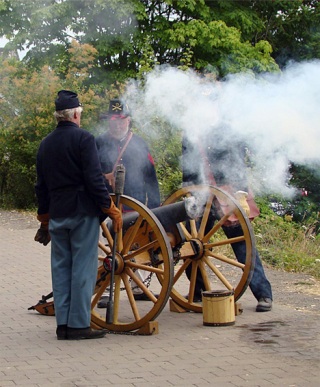One hundred fifty years ago, American and British troops occupied San Juan Island while their two superpower nations began the arduous task of resolving a dispute over ownership of the archipelago.
The occupation brought to the island several nationally-known figures (Gen. Winfield Scott, Brig. Gen. William S. Harney), as well as figures that would later become nationally known (Capt. George Pickett, Lt. Henry Robert). The occupation would change the landscape, leaving buildings and landmarks that remain today. The occupation would itself be distinguished by the fact that no shot was fired in hostility — proof that disputes, even between superpowers, can be resolved peacefully.
You can learn more about what life on the island was like for soldiers during this period at the Memorial Day Weekend Encampment, Saturday and Sunday, 9 a.m. to 5 p.m., at the San Juan Historical Museum, 405 Price St., Friday Harbor.
Admission is $5 and helps support the museum’s programs and building restoration.
Battery D, the reenactment group, will convert the museum grounds into a 1860s military camp.
The museum’s late-1800s buildings — the King farmhouse, carriage house, root cellar, jail, milk house and Scribner cabin — will help set the stage. All buildings will be open for self-guided tours.
Saturday, there will be events every hour on the hour. Concurrently, you can watch blacksmithing, carpentry and other demonstrations. There will be children’s games from the era too.
At 9 a.m., the colors will be raised. At 10 a.m., Battery D will be recruiting soldiers – that could mean you. At 11 a.m., the howitzer will be fired. At noon, hit the chow line for lunch prepared by Mary Jean Cahail and Bonnie Peakes (asked about the menu, museum director Kevin Loftus said in his characteristically colorful way of speaking that “M.J. and Bonnie will be rolling dogs.”)
At 1 p.m., Lynda Guernsey will model women’s fashions from the era. At 2 p.m., watch the men muster for payroll call. At 3 p.m., the howitzer will again be fired. At 4 p.m., the bean cookoff begins; islanders can bring their beans and cooking pot and enter the contest for free. At 5 p.m., the colors will be lowered. The camp should be a lively place after hours, as the reenactors will spend the night at the camp.
No hourly events are scheduled Sunday, just a free-flowing reenactment of 1860s camp life.
The encampment is sponsored by the museum and San Juan Island National Historical Park. It’s a taste of a larger event to come.
The Sesquicentennial Encampment is scheduled July 25-26 at English Camp. This event commemorates the 150th anniversary of the beginning of the joint military occupation.
Reenactors from throughout the region will recreate mid-19th century life on San Juan Island. The major highlight of the weekend will be a visit to Garrison Bay by the tall ships Lady Washington and Hawaiian Chieftain. The British consul general is expected to read a proclamation from Her Majesty’s Government. The Candlelight Ball will follow.



